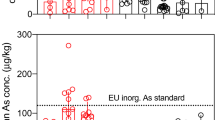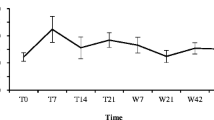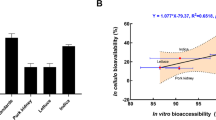Abstract.
Infants are exposed to higher levels of cadmium (Cd) from infant and follow-on formulas than from breast milk. We studied the bioavailability of 109CdCl2 from cows' milk formula, soy formula, wheat/oat/milk formula, wholemeal/milk formula and water in 11-day-old rat pups. The pups received a single oral dose of one diet labelled with 109Cd, 0.1 or 0.3 mg Cd/kg body weight. After 2 or 24 h or 4, 9 or 12 days the fractional retention of 109Cd in the whole body, in segments of rinsed small intestine and in tissue was measured in a gamma counter. Pups receiving 109Cd in water or cows' milk formula had the highest mean whole-body retention. It ranged from 67% of the dose in the water group to 52% in the wholemeal/milk formula group 4 days after dosing. The retention of 109Cd in the rinsed small intestine was significantly higher in the water group and the cows' milk formula group than in the cereal-based formula groups at 24 h and 4 days after dosing. It was still high in all groups on day 9, ranging from 26 to 11%. Initially most of the 109Cd was retained in the duodenum but by day 4 it had moved further down into the jejunum. In the liver, the highest and lowest retention on day 4 was 16‰ and 3‰ of the dose in the water group and wholemeal/milk formula group, respectively. In the kidney, 109Cd was still increasing 12 days after exposure in all groups. Whole-body retention and tissue levels were higher than previously reported in adult animals. The lower bioavailability of 109Cd from the cereal-based formulas compared to water and cows' milk formula on the longer survival times is most likely explained by Cd binding to dietary fibre and phytic acid in the cereal-based formulas reducing the intestinal binding and decreasing the bioavailability of Cd. The high retention of 109Cd in the small intestine, leading to a prolonged absorption period, emphasizes the importance of extending studies on neonatal Cd absorption over a long time period in order to detect for example, endpoints, accumulation of Cd in the kidney.
Similar content being viewed by others
Author information
Authors and Affiliations
Additional information
Electronic Publication
Rights and permissions
About this article
Cite this article
Eklund, G., Petersson Grawé, K. & Oskarsson, A. Bioavailability of cadmium from infant diets in newborn rats. Arch Toxicol 75, 522–530 (2001). https://doi.org/10.1007/s00204-001-0280-z
Received:
Accepted:
Issue Date:
DOI: https://doi.org/10.1007/s00204-001-0280-z




